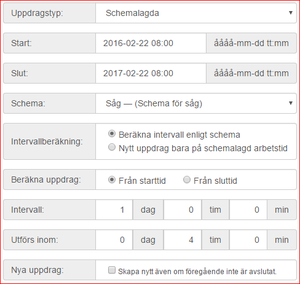Skillnad mellan versioner av "Translations:SIDO Administration/41/en"
Från DataPolarna
Erik (Diskussion | bidrag) (Skapade sidan med '{| style="background:transparent;" | style="width:320px; vertical-align:top; border:0px; padding: .5em 1.5em;" | left | style="width:auto; ve...') |
Erik (Diskussion | bidrag) |
||
| Rad 15: | Rad 15: | ||
If we calculated from endtime, the new assignment should have been activated at 10:00. | If we calculated from endtime, the new assignment should have been activated at 10:00. | ||
| + | |||
|} | |} | ||
Versionen från 7 mars 2016 kl. 15.21
|
Exempel 3 – Scheduled with selected workschedule
The difference compared with example 1 is that when the assignment is signed as completed (at 10:00, 22 february) the new assignment will be created in 1 workday (24 workhours) based on worktime in schedule "Såg". If we calculated from endtime, the new assignment should have been activated at 10:00. |
